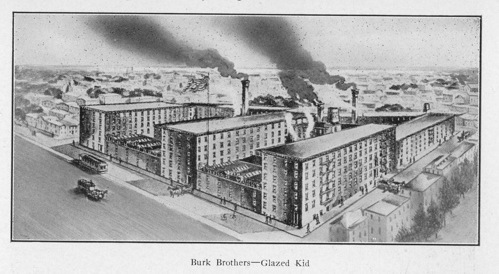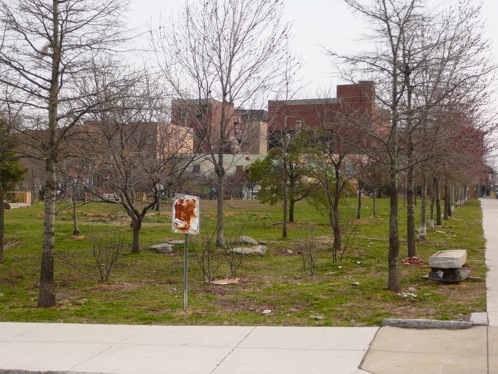
Burk Brothers and Company, 1855
919-961 North 3rd Street, Philadelphia PA 19123
© Roy E. Goodman and David G.
Orr, Ph.D., Workshop of the World (Oliver Evans Press,
1990).
This group of structures
consists of twelve interconnected red brick and
reinforced concrete factory buildings. They represent the
“largest and oldest group of leather industry
buildings” 1
still surviving
in the old leather district of the city. Every one of the
buildings, dating from 1855 to 1913, was designed for the
processing of leather goods of various kinds. The
production of morocco leather by the vegetable tanning
process, the chrome tanning method of making glazed kid
leather and also kid skin are exemplified by this
architecture.
By about 1900, Burk Brothers was one of Philadelphia's
largest and most successful leather firms, second only to
Robert Foerderer of Frankford, Pennsylvania in the
production of glazed kid skins. 2
The manufacture
of leather products and the processing of leather
represented the fifth-largest category of American
industry in 1884. Two zealously-guarded processes which
radically changed the kid leather industry worldwide,
reducing production time from months to days, are closely
associated with Henry Burk who owned the site from 1891
until his death in 1903. 3
Tanning and
finishing kid skins on this site lasted until the
mid-twentieth century. 4
Two buildings of reinforced concrete on the site were
constructed by the Burk Brothers when this building
technology was in its innovative phase. The designer and
builder of one of them was William Steele and Sons Co.,
of Philadelphia, who had designed and built the first
baseball stadium in America to use concrete bleachers
(Shibe Park) in 1909 for the Philadelphia
Athletics. 5
It has been
proposed that the buildings be converted to residential
space.
1 Dorothy B. Templeton,
John Milner Associates, “Nomination
of Burk Brothers and Company to the National Register of
Historic Places,” (1985).
2 Templeton.
3 Brother D. Leo
Quinn, “The
History of Tanning in America,”
(unpublished M.A.
thesis, Villanova University, copy at Villanova
University Library); cited in Templeton.
4 Philadelphia Land
Records, Block 6N12 Lot 214.
5
Templeton.

Liberty Lands
park, looking south from Third & Wildey Streets
towards the remaining buildings of Ortliebs
(2007).
Update May
2007 (by
Torben Jenk):
Nothing survives of the huge
Burk Brothers complex. Purchased by a developer during
the speculative real estate market of the 1980s, the
owner got cold feet in the early 1990s when the federal
government rescinded the tax credits for restoring
historic properties and when the real estate market sank.
In 1993, Mitch Deighan, a neighbor and President of the
Northern Liberties Neighbors Association, asked that the
site be donated to the NLNA. Demolition was mandated by
the City's Department of License & Inspection as a
condition to transfer ownership. Sitting in the NLNA
office in 1995, Deighan, Executive Director Rita
Fitzgerald, and Secretary Karen Kearney wondered what to
do with the land. Kearney suggested "we ought to make a
park there," Deighan added "and call it Liberty Lands."
Fitzgerald pursued grants "to green a 'Brown Fields'
site"—a term used to describe cleaning up a
polluted industrial site. Liberty Lands has grown to
include a vegetable garden, play areas for children, and
grass for playing frisbee and walking dogs. It is also
used for various community festivals.
See
also:
Hexamer General Survey #527 "J.M. Hummel,
Sheep & Calf Skin
Manufactory."
Hexamer General Survey #849-850 (1875)
"E.A. Smith & Bros., Morocco & Fancy Leather
Works."